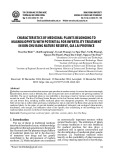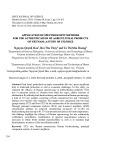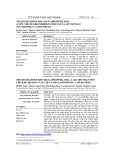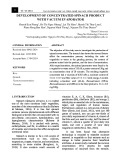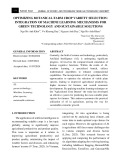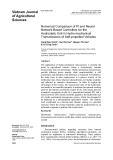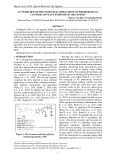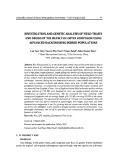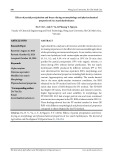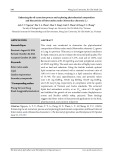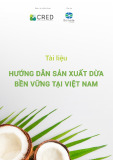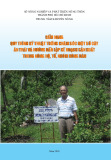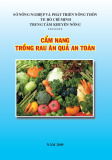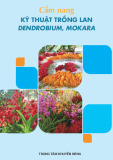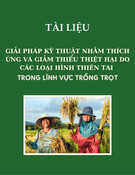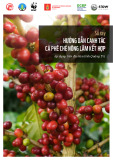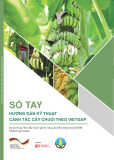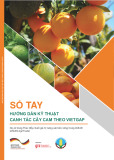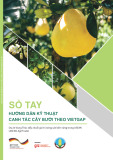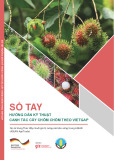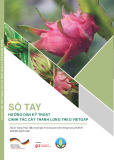
TUYE
Å
N TAÄP KEÁT QUAÛ KHOA HOÏC & COÂNG NGHEÄ 2016
VIEÄN KHOA HOÏC THUÛY LÔÏI MIEÀN NAM 217
RESEARCH ON INFILTRATION SPREAD IN SOIL OF DRIP
IRRIGATION TECHNIQUE FOR GRAPE LEAVES AT THE WATER
SCARCE REGION OF VIETNAM
Tran Thai Hung Tran, Vo Khac Tri, Le Sam
ABSTRACT
The technique of drip irrigation is a solution of water saving for crops in the
scarce region. Water is supplied on the soil surface directly, continuously and
regularly by drippers and then it infiltrates into the cultivated soil layer to ensure
that plants will grow and develop well. During the experimental process of
researching on soil moisture of drip irrigation technique to determine the suitable
irrigation schedule for Grape Leaves at the water scarce region, the authors
carried out the experiment and observed infiltration spread. Based on calculated
and observed results, the authors have proposed correlation of parameters as
follows: infiltration depth, average radius of wetting front on horizontal direction,
irrigation water amount versus time, velocity of horizontal (vr) and vertical (vz)
permeability of drip irrigation technique. The correlation coefficients of
parameters are high (R2 from 0.906 to 0.9899) and conformable to research on soil
moisture dynamic in order to determine the suitable irrigation schedule for Grape
leaves in particular and for terrestrial plants (with short roots) in general at the
water scarce region of the South Central region of Vietnam.
Keywords: Correlation; Drip Irrigation; Infiltration; Irrigation Schedule;
Permeable Velocity
1. INTRODUCTION
The experimental analysis results of water infiltration spread in soil (
H. Darcy,
1885), (
Green and Anpt, 1911), (Kostiakov, 1932), (Phillipe, 1957)… have been
showed that the infiltration process was divided into two phases: unstable infiltration
(absorbent) and stable one. Water spread in soil depends on soil type, structures and
irrigation techniques. For different types of cultivated land, permeability and moisture
reserves in soil is different, so the watering time will be varried depending on each soil
type [1-3].
Irrigation methods and techniques largely influence the water infiltration process
into soil. When soil is irrigated according to traditional methods, water will evenly
saturate and spread from the ground to the bottom. Thus at the location situated between
trees, this water will be wasted, sometimes enable weeds to grow quickly and cause
negative effects on crops. Regarding the drip irrigation technique, water is provided very
reasonable amount from a point on the ground through irrigation equipment, then spreads
out around and bottom, with just enough water volume supplied to moisten the active
roots, soil will reach optimum moisture, without causing waste water and saturation

TUYE
Å
N TAÄP KEÁT QUAÛ KHOA HOÏC & COÂNG NGHEÄ 2016
218 VIEÄN KHOA HOÏC THUÛY LÔÏI MIEÀN NAM
excess. For each plant kind, the active roots have occupied the different volume. The
development of these active roots is very important, when soil is provided adequate water
and nutrients in a reasonable manner, the roots will absorb water, nutrients and air for
plants to grow and develop well, creating high yield and quality product [4].
Previous studies have often focused on the aspect of crops irrigation schedule for
each irrigation technique, not much attention to soil moisture dynamic in the space of
the active roots. Some scientists have studied soil water movement for the traditional
irrigation method (flooding irrigation, ditch irrigation, strip irrigation etc.), but there are
few simulations of drip irrigation technique especially in moisture dynamic (water is
supplied from a point spread around). Thus, it has caused the shortage or excess water
irrigation when the optimal moisture area is larger or less than the active root space.
That does not meet demands in agricultural production and reduce efficiency of water
saving irrigation, especially for water scarce regions.
Binh Thuan and Ninh Thuan are two provinces in the South Central region of
Vietnam with the harsh climate and natural conditions, where has the lowest
precipitation in the country and the unequal distribution by time (annual average is
about 500-800mm). Features of water resources is scarceness, causing drought and
severe water shortage for socioeconomic development, especially agriculture production.
There are more than half a million ethnic minorities whose livelihoods depend on
agricultural activities in this area. Due to difficult production conditions so most of the
population is under the poverty and needs be improved living standards [5].
This performed research is very necessary with the aim to establish correlations
between the parameters as follows: infiltration depth, average radius of wetting front on
horizontal direction, irrigation water amount versus time, velocity of horizontal (vr) and
vertical (vz) permeability of drip irrigation technique for researching on soil moisture
dynamic in order to determine the suitable irrigation schedule for Grape leaves in
particular and for terrestrial plants (with shallow roots) in general, and then it is applied
into cultivating reality to avoid water wastage and get irrigation efficiency at the water
scarce region of the South Central region of Vietnam.
2. MATERIAL AND METHODS
Objective
Researched objective was infiltration spread in soil of drip irrigation technique
with irrigation frequencies as 2 days, 3 days and 4 days.
The experimental model was performed at the Grape leaves farm in Thuan Quy
village, Ham Thuan Nam district, Binh Thuan province.
The mechanical and physical characteristics of soil have been tested in the
laboratory of the Southern Institute of Water Resources Research.
Approachability and methodology
(1) Approach reality and theory comprehensively, combine with selective
inheritance from the scientific research results of infiltration in soil and water-saving

TUYE
Å
N TAÄP KEÁT QUAÛ KHOA HOÏC & COÂNG NGHEÄ 2016
VIEÄN KHOA HOÏC THUÛY LÔÏI MIEÀN NAM 219
irrigation technology for production [4];
(2) Approach structural components of the water utilization models as follows:
source, transport, utilizing exploitation and application of advanced science and
technology about: irrigation equipment, materials, structures, crops and modern
computational software in order to analyse, select and design a experimental model at
the field [2, 6];
(3) Take soil samples at various depths at the field. Analyse mechanical and
physical characteristics of soil in the laboratory;
Figure 1. The sketch of research approachability and methodology
LEGENDS: Z: Infiltration depth (cm); R: Average radius of wetting front on horizontal
direction (cm); W: Irrigation water amount (ml);
T: Time (minute); Vr: Velocity of horizontal permeability (cm/minute); Vz: Velocity of vertical
permeability (cm/minute).
(4) Establish the experimental model, observe irrigation and infiltration spread
development in soil following space (horizontal and vertical permeability) and time
with irrigation frequencies as: 2 days, 3 days and 4 days. Periodically monitor
infiltration spread with time step of 5 minutes/per time as: 1, 3, 5, 10, 15, 20, 25, 30,...
to 200 (minutes) stop watering; then continue monitoring water spread in soil with time
step as: 210, 240, 270, 300, 330 and 360 (minutes) stop observing [5, 7, 8];

TUYE
Å
N TAÄP KEÁT QUAÛ KHOA HOÏC & COÂNG NGHEÄ 2016
220 VIEÄN KHOA HOÏC THUÛY LÔÏI MIEÀN NAM
(5) Establish recurrent correlations between variables: infiltration depth (z),
average radius of wetting front on horizontal direction (r), irrigation water amount (w)
and time (t), velocity of horizontal (vr) and vertical (vz) permeability according to under
research objectives proposed.
(6) Collect observed data and analyze the experimental results by using Excel
and SPSS16 program;
3. RESULTS AND DISCUSSION
The soil at the experimental model was fine sandy with high void ratio, so water
particles have moved by their own gravity component larger than soil capillary force
over themselves (refer with: Table 1).
When water permeates the soil, wet soil block looked like hemispherical. In
initial time, water spread very fast in a circular motion on the ground, velocity of
horizontal permeability (vr) was almost as fast as vertical one (vz) (permeate downward).
During the next phase, velocity of horizontal permeability was smaller than vertical one.
In the last phase, mostly water permeated downward and little horizontal. The
infiltration spread development of each irrigation frequency in soil was as follows (refer
with: Fig. 2 and Table 2):
Two-day irrigation frequency (IF2): With short irrigation one, soil moisture
content was still high so water trended towards the more horizontal permeability beside
the vertical one (downward). In the first 20 minutes, the infiltration velocity of two
directions as vertical and horizontal were rather evenly, z20 = 10.55 - 10.7 cm, r20 = 10.05-
10.25 cm, vz20 = 0.5 cm/min, vr20 = 0.46 cm/min; then the horizontal permeability trended
to slow down although the vertical one was still continuing with less reduction. After 145
minutes, the horizontal velocity decreased small, vr145 was about 0.02 cm/min and lower
than vertical one vz145 = 0.1 cm/min. At the stop watering time (after 200 minutes) z200 =
41- 41.45 cm, r200 = 22.35 – 23 cm, vz200 = 0.08 cm/min, vr200 = 0.01 cm/min, then water
continued permeating to the depth of z360 = 43.8 - 45.4 cm and r360 = 22.9 - 23.8 cm;
Three-day irrigation frequency (IF3): Water regularly permeated around and
downward due to reduced soil moisture more than that one of the IF2. In the first minute,
the vertical infiltration velocity (vz1 = 1.48 cm/min) was faster than the horizontal one (vr1
= 1.35 cm/min); in the next 14 minutes, the infiltration velocity was faster than that one of
the IF2 and rather evenly under two directions (vertical and horizontal); in the next 30
minutes, the infiltration velocity decreased compared with that one of the IF2, z45 = 20.1-
20.75 cm, r45 = 15.5 - 15.75 cm, vz45 = 0.23 cm/min, vr45 = 0.1 cm/min; The next time, the
horizontal velocity trended to slow down during vertical infiltration was still continuing
with less reduction. After 125 minutes, the horizontal velocity decreased small, vr125 was
about 0.02 cm/min and lower than vertical one vz125 = 0.15 cm/min. At the stop watering
time (after 200 minutes), z200 = 42.8 - 43.35 cm, r200 = 20.8 - 21.2 cm, vz200 = 0.08 cm/min,
vr200 = 0.01 cm/min, then water continued permeating to the depth of z360 = 44.8-46.9 cm
and r360 = 21.3 -21.7 cm. Comparing with the same time step for experiment, the
infiltration depth (vertical - z) in the IF3 was larger than that one of the IF2, on the
contrary, the horizontal permeability (r) at the IF3 was smaller than that one in the IF2;

TUYE
Å
N TAÄP KEÁT QUAÛ KHOA HOÏC & COÂNG NGHEÄ 2016
VIEÄN KHOA HOÏC THUÛY LÔÏI MIEÀN NAM 221
Table 1. Soil characteristic of the layers from 0 to 60CM
Soil
layer
(cm)
Grain size analysis Physical characteristic Descriptio
n
Medium Sand
(%)
Fine Sand
(%)
Coarse
Silt
(%)
Fine
Silt (%)
Clay (%)Wet Densit
y
γw (g/cm3)
Dry
Density
γd
(g/cm3)
Specific
Gravity
D
Saturation
S
(%)
Porosity
n
(%)
Void
Ratio
eo
(2.0 -
0.85)
(0.85 -
0.425)
(0.425-
0.25)
(0.25-
0.106)
(0.106-
0.075)
(0.075 -
0.01)
(0.01 -
0.005) (< 0.005)
0-20 0 4.30 47.60 41.50 1.70 0.40 0.50 4.00 1.60 1.56 2.65 8.86 40.99 0.69
Greyish
brown fine
sand
20-40 0 3.50 47.40 36.10 6.40 0.50 0.50 5.60 1.56 1.51 2.63 13.30 42.70 0.75
Greyish
yellow fine
sand
40-60 0 3.80 48.20 35.20 6.10 0.46 0.50 5.74 1.68 1.62 2.64 15.70 38.66 0.63
Greyish
yellow fine
sand
Grain size analysis with five types:
(1) Medium Sand with two grades: 2.0 - 0.85mm, 0.85 - 0.425mm; (2) Fine Sand with three grades: 0.425 - 0.25mm, 0.25 - 0.106mm, 0.106 - 0.075mm; (3)
Coarse Silt with one grade: 0.075 - 0.01mm; (4) Fine Silt with one grade: 0.01 - 0.005mm; (5) Clay with one grade: < 0.005mm.
TUYEÅN TA
Ä
P KEÁT QUAÛ KHOA HO
Ï
C & COÂNG NGHE
Ä
2016
VIE
Ä
N KHOA HO
Ï
C THUÛY LÔ
Ï
I MIEÀN NAM 221

